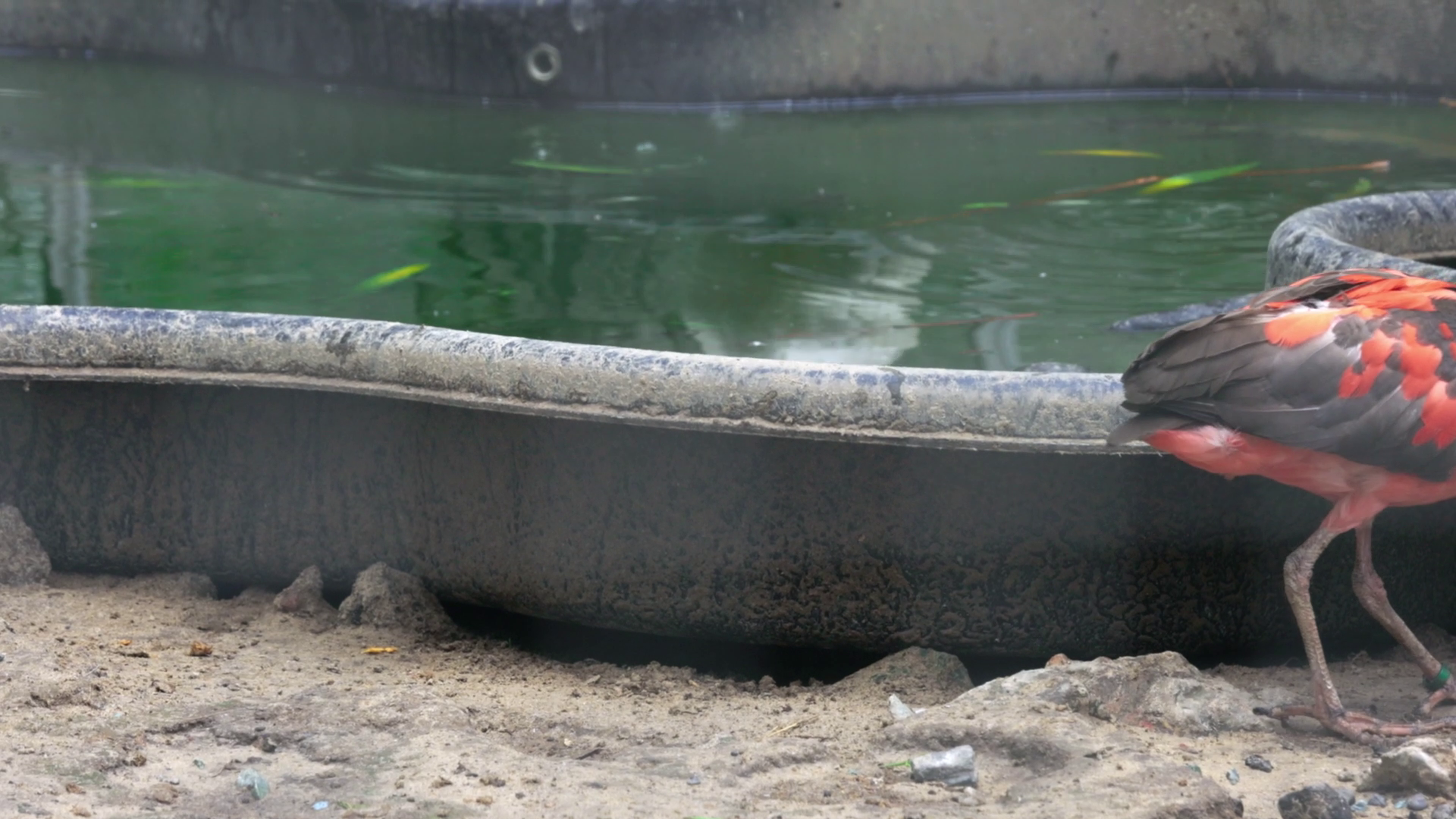AVA
Devices to recoat faded skins,, fired clay, UV-processed leaves, dried salmon skin and flesh, feathers of Scarlet Ibis (Guará), orange peel, various dimensions
Ava, Video Full HD, 9’37’’, Cinematography: Anaïs Chabeur, Editing: Sina Hensel, Anaïs Chabeur, Colour Grading: Lennert de Taeye, Sound Production: Simonluca Laitempergher, Birdkeeper: Marc Dumeez
See what sees you, Astaxanthin (Haematococcus pluvialis), Carotene (Dunaliella salina), resin eco, metal, fabric, 240 x 105cm, 35 x 20cm
Supported by Beursschouwburg- Multidisciplinary Art Center Brussels, BE and VLAANDEREN DEPARTEMENT CULTUUR, JEUGD & MEDIA, and with the help of Gloriya Avgust, Werner Musenbrock, Sarah Smolders, Tom Volkaert, Luca School of Arts Antwerp, Tineke Schuurmans, Verbeke Foundation
A string is knotted to form a circle, then a play of finger movements knots the thread into shapes and patterns commonly called string figures. The exhibition lays out a string game for multiple players. It is an invitation to tune into different understandings of colour, delving into the intertwining dynamics that tie human and other-than-human beings in relation to one another. Organisms constantly release, share and are traversed by colours. In recounting these passages, Sina Hensel’s narrative strategy is akin to the practice of making string figures that Donna Haraway describes as a way of composing multispecies storytelling’ or ‘multispecies worlding’.1 Relationship is at the center of how Hensel envisages the process of making, where each step reminds us that - to use Haraway’s words again - ‘[n]atures, cultures, subjects, and objects do not preexist their intertwined worldings.’2 Departing from an understanding of the environment as a set of relations, the exhibition brings together traces and devices of colour-shifting processes that reveal how changes in pigmentation are entangled with dynamics of care and nurture but also serve as warning signals of affliction and distress.
FIRST KNOT: ALGAE SECRETE PIGMENTS
Cultivating requires care, attention and time. These are the ingredients that the artist deploys to grow different species of algae from which she extracts pigments to make natural dyes. The specific algae that gave her the red pigment used to colour the fabric and resin panels in the exhibition, is a micro-organism containing astaxanthin, a red pigment that is notably released due to UV-light exposure, nutrient inhibition, high salinity or other types of environmental stress. Its red coating simultaneously acts as a protection screen and as a signal of distress. This pigment serves as the red thread that runs through the exhibition.
SECOND KNOT: THEY TRAVERSE OTHER ORGANISMS
That same chemical compound (astaxanthin) is also found in salmon, krill, shrimp and other life forms that are accustomed to ingesting algae on a regular basis. However, in the artificial environment of an aquatic farm or a birdhouse, synthetically produced pigments are added to the animals’ diet to ‘preserve’ the bright colour of their flesh, skin or feathers. The Guarà bird that we see in the video, also known as red or scarlet ibis, is an indigenous species of several regions in South America and the Caribbean. The bird metabolises carotenoid pigments which flow into its feathers and dye them red over time. Moved from an overcrowded birdhouse of the Antwerp zoo, some Guarà birds found a new home at the Verbeke Foundation (BE), where Hensel paid them monthly visits in order to capture the gradual transformation of their colour palette. The images of these displaced birds point to the role of habitat, metabolic and nurturing processes in rendering colour shifts as secretions of environmental information. The wallpaper at the entrance of the gallery and in the hall displays a series of film stills in a pictorial mosaic that highlights the colours of the birds and of their surroundings. The clay sculptures laying on the ground wear the traces of feathers, salmon skin and orange peelings which, following the logic of synthetic bird and fish food, are also made more alluring on (super)market stalls through the use of man-made pigments. These matters, subject to artificially induced colour alterations, inhabit the space like fossils, sediments or shadows.
THIRD KNOT: HEAT HOLDS THEM IN ITS GRIP
We often think of heat as a protective element. We use blankets, heaters and hot water bottles to soothe our sorrows and protect ourselves from the staggering cold. Heat is also an essential component of the dyeing process, as it allows the pigment to sink into the fabric. Between sculptures and tools, the ceramic heaters disseminated throughout the space allude to the artist’s process but also introduce air as a tangible element and active protagonist of this story.
FOURTH KNOT: AND SUNLIGHT PULLS THEM AWAY
From sunburnt skin to algae turning red, several organisms react to sunlight (UV) with pigment secretions. Other materials, like dyed fabric, will tend to lose their glow under the sun. The shifting colours that populate the exhibition generate a language of their own, one that speaks through gradual change, erosion and eventually erasure. Hensel uses pigment extraction and dyeing techniques to observe patterns of reaction and transformation. The large resin panels as well as the samples of red fabric disseminated throughout the space are dyed with the same pigment but will react differently to the broad daylight to which they are exposed. Colour will fade away at different paces. Here, the exhibition space functions like a laboratory that explores the effects of daylight on different dyed supports.
From one knot to another, a pattern unfolds. It is called Ava. The roots of the name Ava are multiple, but it is around its derivation from avis, which means bird or birdlike in Latin, that this story revolves. From the process of dyeing resin to the feather coat of Guarà birds, colour becomes a lens through which signs of environmental change can be read and experienced.
1 Donna J. Haraway, Staying with the Trouble, Making Kin in the Chtulucene, Duke University Press: Durham and London, 2016, p.10.
2 Ibidem, p.13
Sofia Dati, curator at Beursschouwburg- Multidisciplinary Art Center, Brussels/BE
Photos by Fabien Silvestre Suzor, Sina Hensel
Article by Jasper Delva in HART Magazine: https://hart-magazine.be/expo/sina-hensel-in-de-beursschouwburg




















